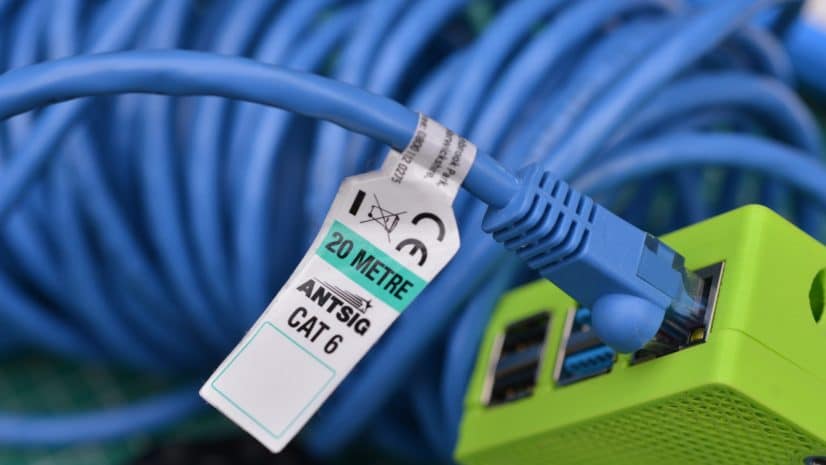Modern digital communications operate at high speeds, and Cat6 is one industry-standard tier of Ethernet cabling allowing businesses to leverage high-speed communications. Considered the sixth generation of Ethernet cabling, Cat6 cabling consists of four twisted pairs of copper conductors that can transmit up to 10 Gb of data per second over short distances.
This tier of cabling is more affordable than ever. When it was first introduced in the early 2000s, Cat6 was about 50 percent more expensive than the previous generation of cabling. As production was brought up to scale, costs dropped significantly over the years and now the cost of a Cat6 installation is extremely competitive.
The use of Cat6 cabling has become so widely accepted that many modern building codes have standardized its installation. Many older commercial buildings have also been upgraded to offer better speeds and greater reliability.
What Does a Typical Cat6 Cable Installation Look Like?
Commercial installers use long spools of Cat6 cable measuring 500 to 1000 feet in length. To create point-to-point connections, or drops, installers cut smaller lengths from these larger spools that typically measure 300 feet or less. Longer lengths of Cat6 cable are not typically used because copper wiring is not rated for reliability past 300 feet.
A common pricing approach for Cat6 installation is on a per-drop basis. Companies looking to get a consultation for their installation should know the number of drops needed in order to facilitate the discussion and get an accurate quote.
Types of Cat6 Cabling
Cat6 cabling can be classified based on shielding type (shielded or unshielded), copper conductor pairs (solid or stranded), and cable jacket rating (CM, CMR and CMP).
Unshielded Cat6 cable (UTP Cat6) has wires twisted together to minimize crosstalk and noise. Shielded Cat6 contained a twisted pair of cables within a mesh or foil shield that protects against electromagnetic interference.
Solid cable is made up of a single piece of copper, while stranded cable is comprised of multiple copper cables wound together. Solid cables are less flexible and more robust, making them ideal for permanent installations inside walls or buried underground. Stranded cables are more flexible but have high attenuation. Because of this, stranded cable is typically used as patch cables less than 6 meters long.
Established by the National Electric Code (NEC), jacket ratings describe the outer casing that protects a cable’s wiring and insulation from physical damage, water and electromagnetic radiation. Cat6 CM cables have the minimum protection allowed under the NEC and are best for small-scale uses. Cat6 CMR cables are rated for use in the risers of commercial buildings due to their fire protection qualities. Rated for use in plenums, Cat6 CMP cables not only prevent the spread of fire, but they also give off less toxic fumes and smoke when burning. Because most homes don’t have significant plenum spaces, these cables are typically meant for commercial installations in large buildings.
Cat6 Cable Uses
Having the capacity for high speeds and minimal crosstalk, Cat6 cable has become a popular choice for enterprise networks. A common use of Cat6 cable is to employ it in combination with fiber optics as the backbone of a network. Because it is more reliable than previous generations of Ethernet cable, Cat6 is more suitable for the current wave of 60W and 90W Power over Ethernet (PoE) technologies.
Cat6 cable is also frequently the cable of choice for outdoor applications, such as for outdoor surveillance or when two buildings must be connected. It functions well in underground connections.
Cat6 Cable Benefits and Features
Several features of Cat6 cause it to perform better than previous generations of Ethernet cable. Perhaps its biggest advantages over the previous generation of Ethernet cables are greater bandwidth (250 MHz) and a higher maximum data rate (10 Gbps). This is why Cat6 cables have become the standard for new installations.
Cat6 cables also offer superior protection against crosstalk. Some Cat6 cables achieve this with a feature called a “spline” that separates individual wires. This feature also prevents stretching and it makes Cat6 cables more resilient. However, it also makes them somewhat rigid and challenging to use in tight turns. Instead of a spline, some Cat6 cables have shielding for individual wires, which is typically indicated by an “S” tacked on to the name.
Contact Taylored Systems for an Installation Quote
If you’re considering an installation with Cat6 cabling and have questions, we would love to answer them and address your concerns. After hearing about the goals for your installation and requirements, we can provide a free and fast site survey that will address any questions regarding your specific installation.
We currently serve Indianapolis, Noblesville, Carmel, Columbus, Plainfield, Westfield, Whitestown and the rest of Central Indiana. Reach out to us today to discuss the possibilities!

